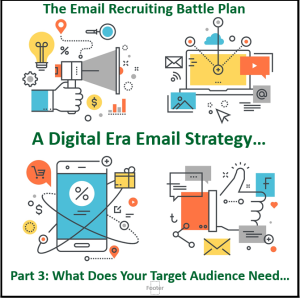Our goal of this series of articles is to illustrate how to double your email recruiting results. The first installment of the email recruiting campaign provided an overview of the digital battlefield that is key to participation in the war for talent. We discussed the speed in which decision are made about your email campaigns and signposted the discussions that will occur in the other five installments in the series of articles on email recruiting. The second chapter is covering why we need a strategy or battle plan for the digital battlefield. Our email recruiting battle plan is being voiced in three parts based on some questions you should ask yourself before designing your email strategy. Part one provided some insights into the persona of the target audience, who they are regarding composition. This time in part two of the battle plan discussion, we will explore the mind of your target audience.

Your strategy is; the battle plan for the battle of the inbox on the digital battlefield. As the discussion expands into part two, we will look at some additional factors that can be incorporated in the tactics that comprise your email strategy. Last time, we unpacked Who Is Your Target Audience. We looked at the target audience regarding its competitiveness, the rise of giggers, as well as the considerations of a multigenerational and a diverse workforce. This time, we are going to dive deeper into the primary influences on the mind of your target audience.
How does your target audience think? The early days of our digital era have been marked by the social revolution. Over the past decade, the paradigm shifting reality has sunk in, the balance of power has shifted from organizations with their self-promoting brand messages to the people and more specifically to the very customers themselves. The digital behaviors of target audiences can be characterized by three observations.
- Power to the People
- Social revolutions are disruptive, rule breaking and game-changing. The most recent social event took place in cyberspace. It is no less impactful than previous social revolts that took place in the streets. What began as an idea became a groundswell. The result is that a target audience determines your brand identity by how it experiences your brand in cyberspace.
- The impact of power belonging to the people. So how does that relate to email recruiting? Simply, your talent brand will be experienced in cyberspace (or not experienced at all). Best practices suggest you provide a transparent, user-friendly, and experiential offering to your target talent audience. Recognizing and respecting who is in control of the relationship is very important to the tone of the email messaging.
- A DIY (Do It Yourself) Mentality (Pioneering Spirit)
- In business, the first positions that were eliminated were the assistants. As organizational structures flattened, self-sufficiency was mandatory. In the social realm, a DIY movement evolved. Ironically, it began with self-help and moved into the home improvement arena. From its diverse roots, the DIY movement has moved into cyberspace. Finding out what Google thinks about a subject has become the first step in research. That is followed by reading the linked articles to understand the subject better. Next, review sites are consulted with product experiences carefully studied. Friends and family are consulted on Facebook or other favorite social platform. Additional resources will be consulted as necessary to decide. The bottom line is that today’s consumer wants to make up their mind about a product before engaging the company behind the brand, without the bias of a corporate message.
- The impact of the consumer mindset. The consumer mindset relates directly to your email campaign as your call to action will engage the digital behaviors of today’s online consumer. Whether buying a toaster or applying for a job, the process is similar. They want to make up their minds about your brand, not be told by a corporate mouthpiece how they should think about your brand. The buyer’s process to make a purchase is known as a buyer’s journey; so in talent acquisition, it is called a candidate journey. Your emails will need to recognize the consumer mindset, and the journey target talent takes to decide. Successful email campaigns will leverage career sites that provide access to the information that talent needs to make up their minds.
- Is it really about trust?
- Revolutions typically occur when the people do not trust the established powers. A lack of trust was certainly a precursor to this social revolution. False claims, bad behavior, and bad products created a consumer movement. Profit seeking at all cost generated significant collateral damage to the workforce and created an environment where loyalty to one’s profession is a core requirement for talent. Profession focused affinity groups have created communities where experiences, ideas, and opinions are shared. The vision of a computer on every desk has given rise to the fact that every desk now has multiple devices that combine for one voice that will be amplified into multiple channels. It seems that even the most introverted are not bashful in cyberspace. Everyone has a story to be shared; the audience is waiting.
- The impact of trust. The result is that communal opinions are sought after, valued, and more trusted more than corporate brand messages. Strangers are trusted more than familiar brands. The answer is to showcase your employees rather than the well-dressed, polished professional PR or marketing spokesperson. Best in class organizations have recruited brand ambassadors from their ranks to share their stories. Email campaigns that invite target talent to listen to employee testimony work well.
Knowing you’re the mind of your target audience is the second part of designing an email communication strategy in the digital era. The second part of the all-important talent persona incorporates the thinking that talent is in control of the relationship and our ability to connect with them is based on trust that is built by us providing information that mirrors the internet based consumer purchasing model.
Next time I will discuss the third part of developing the strategic target talent persona, digging deep into the target talent audience needs.

Outline: A Digital Era Email Strategy
- The Inbox Is The Battlefield In The Digital War For Talent
- The Email Recruiting Battle Plan: A Digital Era Email Strategy
- Who is Your Target Audience?
- How Does Your Target Audience Think?
- What Does Your Target Audience Need?
- The First 3 Seconds-Guess What I Have For You.
- The Next 5 Seconds-Why You Should Want It!
- The Final 7 Seconds-How You Can Get It!
- Before You Press Send–An Email Recruiting Checklist.
Images: Graphicstock
